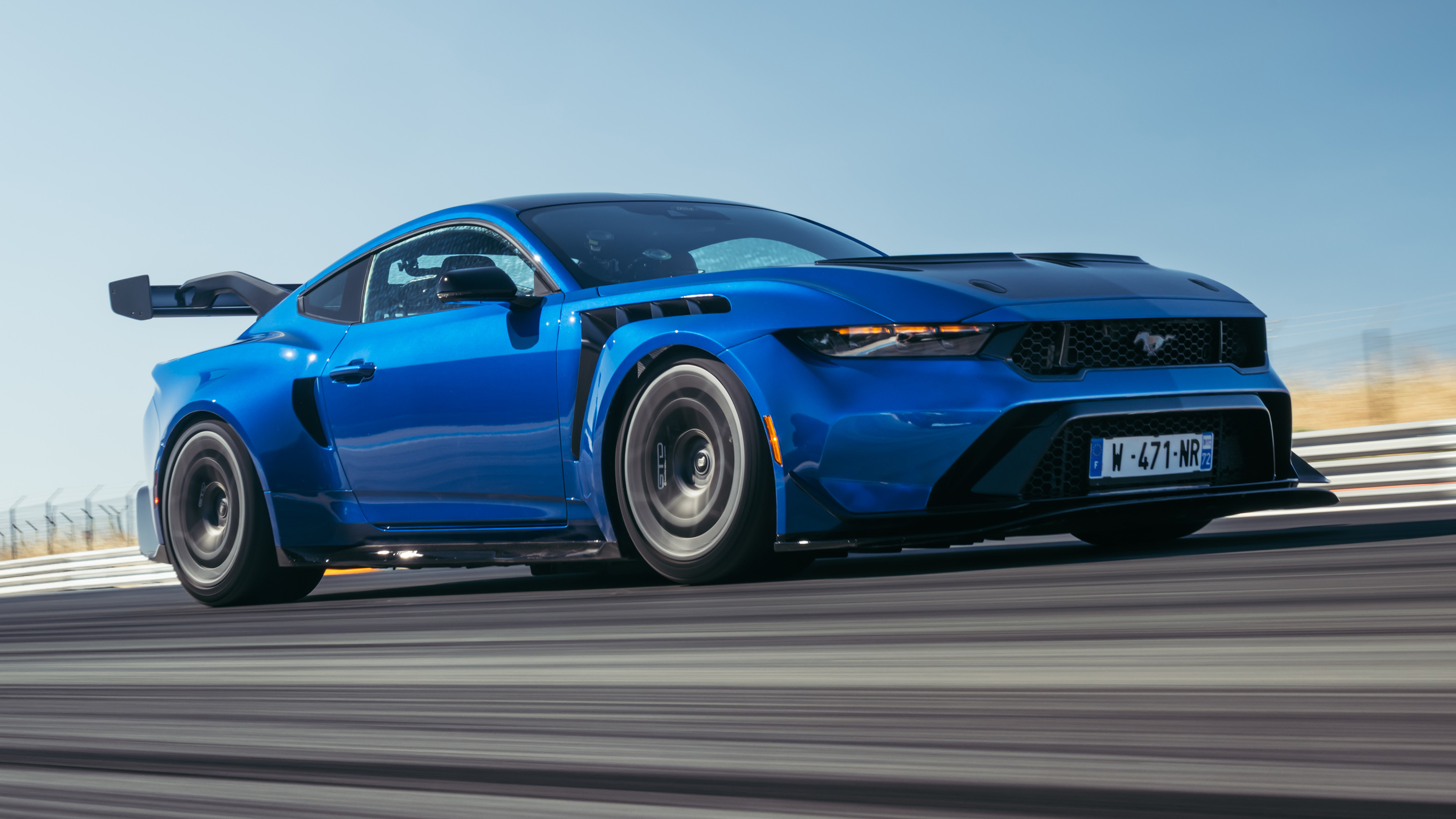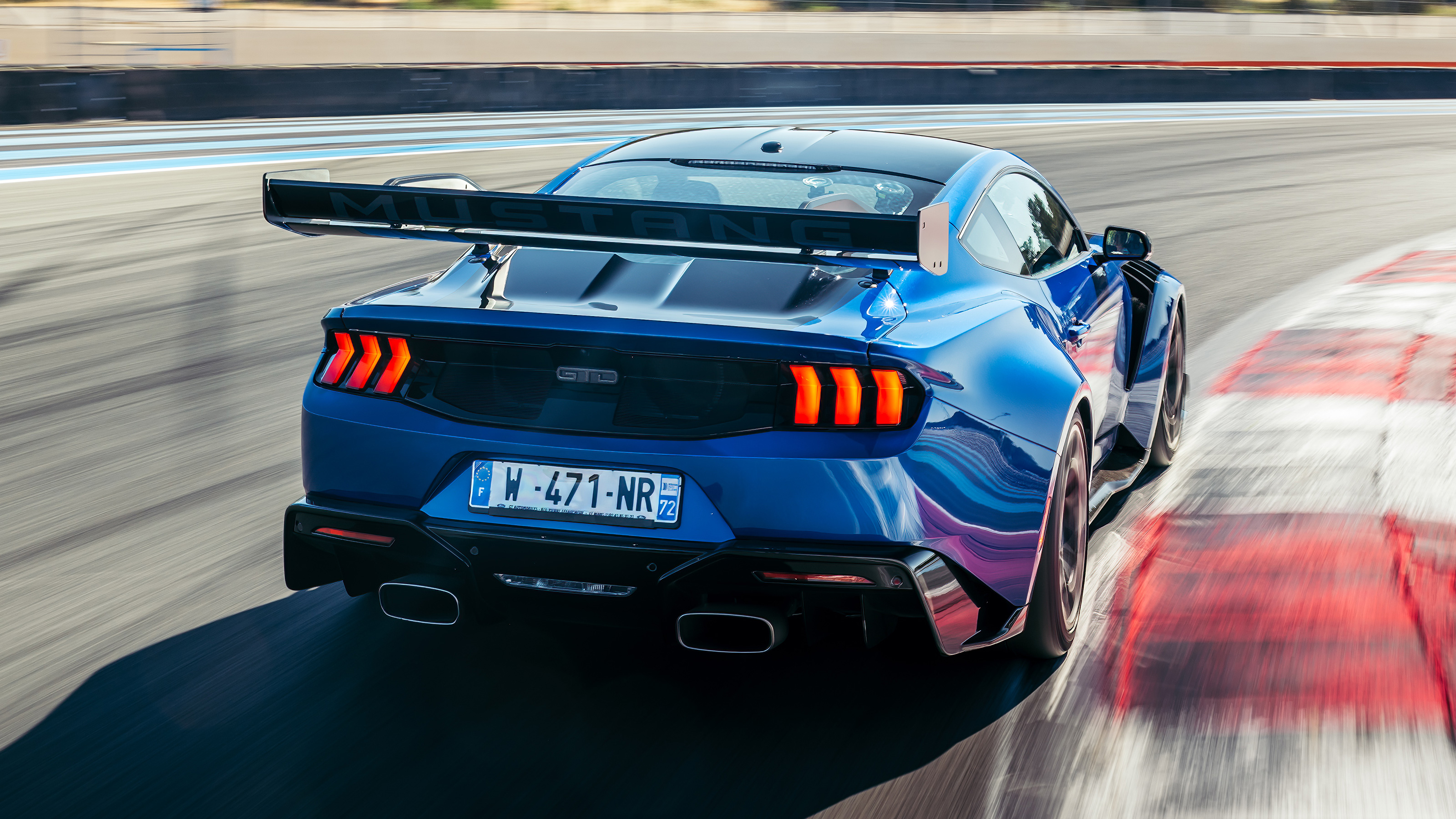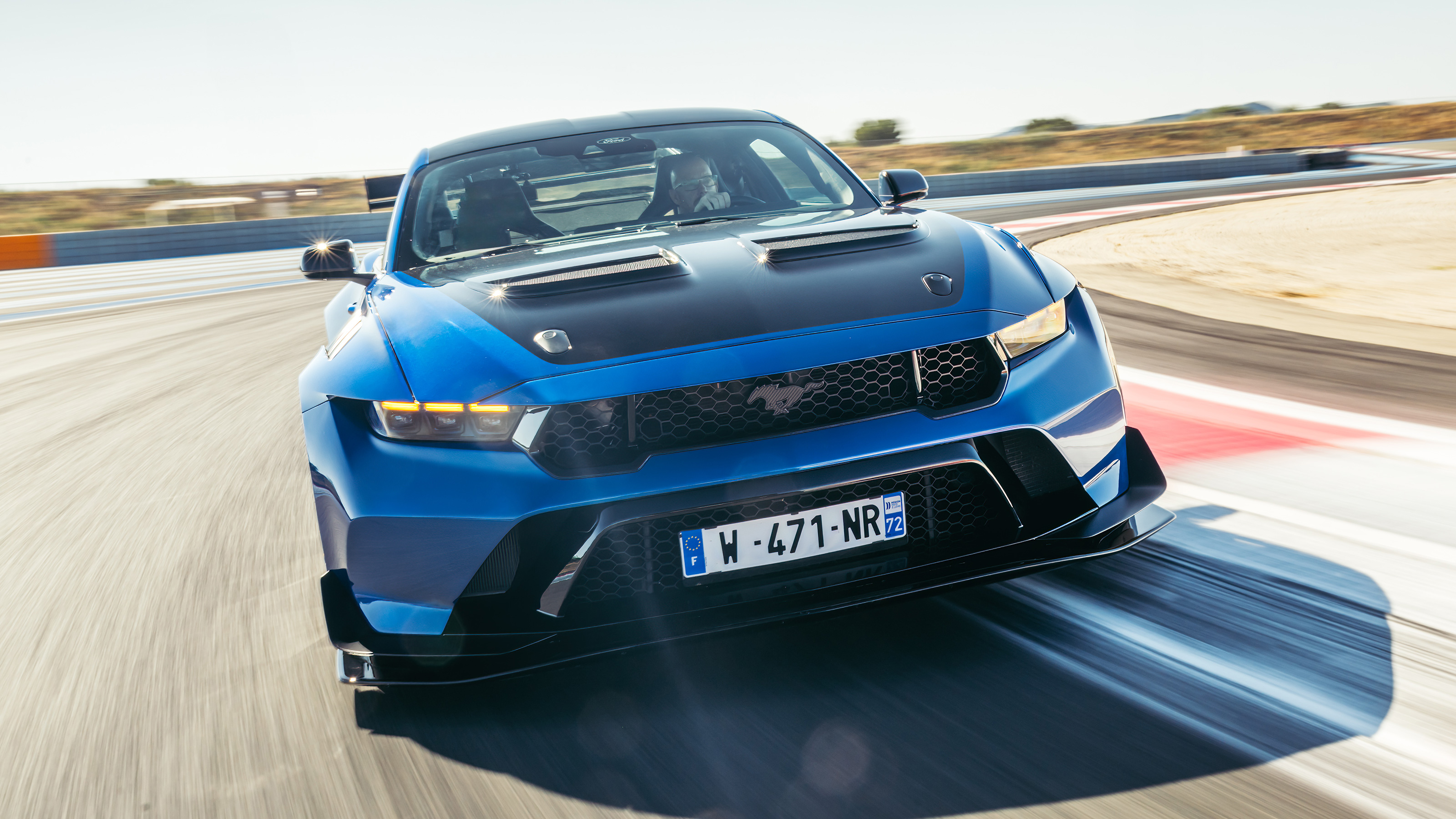
Ford Mustang GTD review: Ford applies supercar logic to its tyre-shredding muscle car
£315,000 when new
Ah, the car with anger management issues!
Just because it’s been styled by testosterone doesn’t mean the Ford Mustang GTD doesn’t have a softer side. You just have to dig a bit to find it (and you’ll keep digging until you get to the super-sophisticated damping, more of which anon).
But come on, it’s the most aggressive thing I’ve seen outside a UFC arena.
It does admittedly have the pumped gym rat aesthetic down pat. The width, the stance, the swagger, slats and bulges. At 2,080mm wide, it’s over 150mm wider than a regular Mustang. Now normally, when firms do hardcore models they might add an extra 40-50mm of width. But 150mm is practically unheard of and speaks volumes for the depths of alterations that have been made.
Come on then, how deep are we talking?
Deep enough that I’m not sure Ford can recoup the investment it must have made in the profits it can turn from the 1,000 that are being built. Yes, even though it costs getting on for ten times as much as a base Mustang. $325,000 in the US, or £315,000 in the UK (left hand-drive only).
OK yes, slight exaggeration as Ford has a £315 million payday coming now all have been spoken for. But even so, it’s important to see this car as a brand builder as much as a standalone model. No, that doesn’t mean we should expect a Focus RS to magically reappear in the range anytime soon, but it does mean Ford wants to be seen as a mainstream brand that really cares about driving dynamics. Is a WRC-inspired 4WD Puma too much to hope for?
Probably, yes, but you digressed. We were talking alterations.
Ford got Multimatic on board to help. The last time they did this was for the GT, and the learnings from that car – and some of the features – have been passed on. Including the hydraulic suspension that drops it 40mm into track mode so fast it’s like it’s just been sat on.
The trouble is that what we’re talking about here isn’t just a track version of an already sporty car – Porsche has it relatively easy turning a regular 911 into a GT3 RS (the most steely-eyed track machine of them all and the car Ford has explicitly targeted). Instead it’s something much more fundamental: turning a tyre-shredding muscle car that specialises in burnouts into a tenacious track weapon that specialises in apexes. Apices. Or alternatively: turning an engine car into a chassis car.
The front suspension has clearly come in for some work, but at least it’s mounted to an existing (albeit heavily reinforced) subframe. The rear of the car is entirely new. And there’s no boot – sorry, trunk – at all.
Two things necessitated a unique rear sub-frame: weight distribution and suspension. Achieving a 50:50 weight split meant shifting the gearbox and some of the cooling to the back, and that wasn’t going to work with the existing layout. Plus, it was only in 2014 that the Mustang stopped being fitted with a solid rear axle and gained independent suspension. However, something much more specialized was called for here: inboard suspension with DSSV spool dampers.
And a porthole where the rear seats should be.
Careful where you direct the mirror while driving – they’re rather distracting. Anyway, spool valves replace a conventional damper’s shim stack and instead control fluid flow through small adjustable tubes. More precise, more adjustable, better heat resistance etc. And much better able to withstand the effects of 600kg of downforce created by that adjustable rear wing at 155mph.
That’s a lot of drag. I trust it has oodles of power to deal with that?
Oh boy yeah. It uses a heavily uprated, dry-sumped version of the 5.2-litre supercharged V8 fitted to the Mustang GT500, yielding 815bhp and 664lb ft of torque. But more than that it yields noise. Primordial, Cretaceous noise. Stand and watch as it thunders past and it screeches towards you, supercharger yowling, a compressive doppler that morphs into an utterly ferocious exhaust as it charges past. It’s mega. And won’t be coming to Europe. This is a US-spec set-up, European regs demand something tamer. Got one coming? You know what to do.
Top Gear
Newsletter
Thank you for subscribing to our newsletter. Look out for your regular round-up of news, reviews and offers in your inbox.
Get all the latest news, reviews and exclusives, direct to your inbox.
Why, that’s 300bhp more than a GT3 RS, it must be so much faster.
You’d think so, wouldn’t you? But actually it uses that extra 300bhp to go three seconds slower around the Nurburgring than its deadliest rival: 6m 52.072s versus 6m 49.328s
I sense a weighty issue at play here…
We feared it was coming, didn’t we? But carbon body panels and magnesium wheels can only do so much when you’re also adding extra stiffening all over the place and huge components. I’m not kidding, get up close to the porthole and you realise just how outsize those dampers are, like the pistons off steam trains. And so it continues around the car: brakes, splitter, vents – it’s not just the wing that’s ginormous. And all necessarily huge to support the weight, which climbs because the components are big and so on and so forth.
But more than that it yields noise. Primordial, Cretaceous noise
End result? 1,930kg in its lightest guise. Which is half a tonne up on the Porsche and, as far as I can work out, makes this the heaviest Mustang there’s ever been. Let me know if that’s wide of the mark.
Can you tell when you’re driving?
Most of the time, no. Firstly because it manages its weight so well and secondly because you’re having too much of a good time to care.
I wasn’t sure I was going to at first. The cabin feels a bit tame, a bit ordinary after the exterior savagery. The only seats are big, plush and chunky; supportive, but they don’t lock you in place like a carbon bucket. And there’s no roll cage. Ford says that the parts aftermarket in the US is so popular that they didn’t need to, but I reckon they’ve missed a trick – and an opportunity to squeeze a bit more cash out of buyers.
But as soon as it starts moving, even at low road speeds, it does everything professionally. No wayward movement, no chassis shudder or suspension tremor, no gearbox slack. Nothing like an ordinary Mustang in other words. It starts like a Mustang, huge V8 roar, but from the moment you click the Tremec twin clutch ‘box into first, it’s a world away.
Not quite the precision of the GT3, but an ability to deal with everything with one input and move on. The way it rounds off bumps, smooths out rough surfaces and almost never loses its composure on road or track feels, well, luxurious. Weight plays its part there, smothering small stuff, the Mustang rarely thrown off course, but there’s more than enough finesse and adjustability on track to make this a deeply fulfilling car to drive.
And what’s it like as a track car?
It’s one of the most engaging, indulgent and entertaining I’ve ever driven. Because it hits you at so many levels. No-one is immune to engine noise like this. Everyone can appreciate handling that’s this well balanced and accessible. In some track cars – and I’d include the GT3 RS in this, the barrier to entry can seem quite high, like the car’s suggesting you’re not good enough. The GTD isn’t like that. It’s a bear hug of a car.
But what about if you are a track warrior?
It’s not a dancer, doesn’t switch direction like the Porsche, isn’t as locked down. I wasn’t expecting sensational steering feedback and I didn’t get it, there’s not a great deal of sensitivity there, but it’s crisp and well weighted enough to give me faith. No lag or delay from the supercharged V8, just massive, instant torque and a constant barrage of cackling, gargling and roaring. And the gearshifts punch through hard and fast.
Oh, and the brakes are downright sensational. Wouldn’t mind a firmer, shorter pedal, but the stopping power, the sheer force you can put through those vast 325-section front tyres is plain ridiculous. Under cornering as well as slowing. It’s a mighty thing for corner entry (and exit come to that) because front and rear axles are so in tune with each other.
The rival it reminds me most of is AMG’s GT Black Series, a proper locked down, race-inspired, GT3 RS-adjacent track machine. This is more playful, has a larger handling sweet spot, and a gung-ho attitude that I can’t get enough of. Where the Black Series and GT3 RS satisfy the detail geek in all of us, the GTD delivers earthier pleasures.
Don’t think that means it’s a drift car – it will slide around, but really it’s set up to drive cleanly into, through and out of corners. It flows well. I thunder around Paul Ricard, bodywork vibrating, brakes pounding, engine roaring and reckon I’m having a better time out here than I would be in just about anything else and hang the lap times. Because who cares, really?
Anything to be concerned about?
Above 165mph down the 1.8km Mistral Straight, I thought the GTD might be about to pull itself apart. The mirrors blurred, the bodywork started buzzing, the seats were vibrating, the whole car hummed with energy and strain.
It’s not that the GTD felt like it was going to pull itself apart, more that it was making me aware of the tension and effort it’s putting itself through on its way to hitting 180mph. I was aware of the speed, of how hard it was working to achieve it.
The mirrors blurred, the bodywork started buzzing, the seats were vibrating, the whole car hummed with energy and strain
So it’s physical to drive, you feel the tension in the car and it only struggles to manage its weight when the heat build-up starts to wilt the brakes and tyres. But by then the fuel tank is empty. It’s got a thirst on it like nothing else, the GTD. 50 miles and it’s parched.
Does it work on road as well?
In many ways it’s a better road car than track car. It’s not as connected, pure and intimate to drive on track as the GT3 RS but it’s a way better feelgood road car, because despite its new-found track ability it hasn’t lost what it means to be a Mustang. You can still hang an elbow out the window and just cruise. Or do a vast burnout. Or thump a couple of hundred miles aside without every surface change being a punctuation mark. It can be easy-going and relaxed in a way no other track car quite matches. And I think in the US it’s going to be greeted as the greatest thing since the Constitution.
What about in Europe?
I suspect most people who can afford one and like track driving will be sniffy about it, see it as beneath them, as not having the right badge, the right engine, the right look or the right image. Trouble is they’d be missing out. Because it has the right stuff.
Featured

Trending this week
- Car Review
Mazda MX-5
- Car Review
Peugeot E-308






